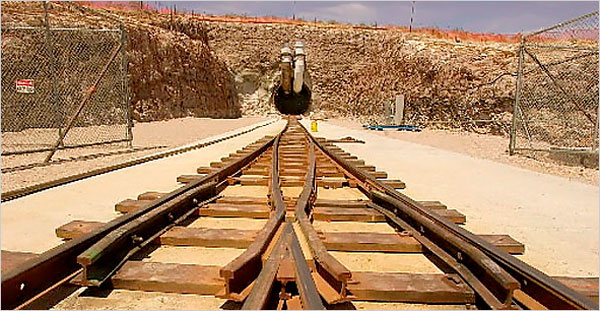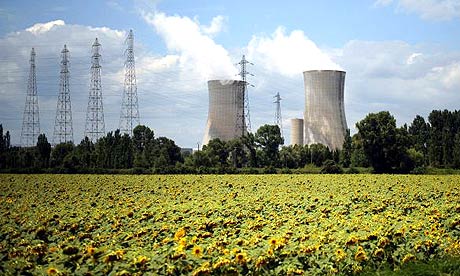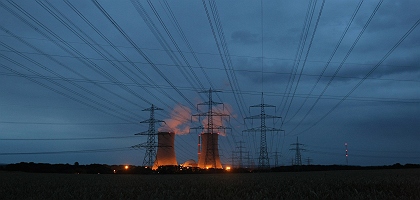Re Ian Bremmer 'Could third-party candidates upend the 2024 US election?' 3 April The current political movement in the USA…
Nuclear energy comeback
Written by Diana Thebaud Nicholson // February 17, 2010 // Nuclear, Public Policy // 2 Comments
More on AECL and nuclear and on Wednesday-Night.com ; Nuclear waste and a communications conundrum
Nuclear plant rebuild could cost $10B: minister
TORONTO — It will cost between $6 billion and $10 billion to refurbish the Darlington nuclear power station to extend its life by another 30 to 40 years.
Energy Minister Brad Duguid released today what he calls the “best possible preliminary cost estimate,” one day after Ontario Power Generation confirmed it would refurbish the plant.
30 October 2009
Frank Kinnelly writes:
Have you seen anything about this concept? They do seem to have put together an impressive advisory group, but so many good ideas about nuclear have come to naught in Canada. and Douglas Lightfoot replies: I know Dan Meneley personally and consider him to be well qualified to identify and select a good process for small reactors. I was the lead author on the paper “Nuclear fission fuel is inexhaustible”. Dan was one of four other authors. I found him easy to work with. There is lots of interest in small reactors these days for remote locations.
Western Troy to Initiate Small Nuclear Reactor Venture
Western Troy Capital Resources Inc. has announced that it plans to form a wholly owned private corporation to provide small nuclear reactor electric power generating stations for installation in remote locations in Canada and elsewhere.
8 October
The Kerry-Boxer Bill and Nuclear Energy
Could nuclear power be the key to the Senate energy and climate bill?
1 October
US energy bill backs nuclear industry
(FT) The US nuclear energy industry is set to receive significant support for building new reactors, research and development, and training more highly-skilled staff under the Democratic climate change bill introduced to the Senate this week. Increasing the supply of nuclear power is a key plank of the Clean Energy Jobs and American Power Act ….
1 August
Is There a Place for Nuclear Waste?
(Scientific American August 2009) Yucca Mountain was supposed to be the answer to the U.S.’s nuclear waste problem, but after 22 years and $9 billion, that vision is dead. Now, some say that doing nothing in the near term may be the smartest solution
Key Concepts
* The Obama administration has effectively canceled the plan to store nuclear waste at Yucca Mountain.
* Spent fuel will for the foreseeable future continue to be stored on-site at 131 locations around the country.
* The end of Yucca means that all options for waste disposal are now in play, including recycling, use in advanced reactors and burial at other sites.
Comment from Douglas Lightfoot
… makes some good points, such as, the longer you keep the waste, the less problem it is, but tends to miss the point that the waste is about 99% U238, which is good fuel for fast reactors. We must always be able to get at the waste to recycle it.
The Canadian Nuclear Waste Management Organization recognizes this and it is part of the Canadian plan.
The points missed by this article are:
*If we are to have a reliable and sufficient electricity supply, it has to ultimately come from nuclear. (When electricity stops, everything stops!)
*Using cost to try to distinguish between alternatives works in some cases, but not in this one.
*The fact that we have to make fast breeders work to have sufficient electricity for thousands of years is not mentioned in this article. Fast breeders use metal fuel and during the recycling process, there is no weapons grade plutonium.
The US was ahead of everyone in the mid-1990s when they canceled the Integral Fast Reactor (IFR) for political reasons. Now they are behind Russia, India, France and Japan. The fact that recycling is outlawed in the US, has hampered progress. It has not stopped proliferation.
7 March
Future Dim for Nuclear Waste Repository

A little-used portal into Yucca Mountain, the proposed site for a
national nuclear power waste facility that now seems unlikely to happen.
(Photo, The Associated Press)
(NYT) The political wind is blowing so strongly against using Yucca Mountain that the nuclear industry’s trade association is not opposing Mr. Obama head-on. Instead, in response to his budget proposal, it called for creation of an independent panel to study how the government should meet its “legal and moral obligation” to take the waste. Mr. Obama himself is calling for more study.
Frank Kinnelly predicted this in November 2008: “With both Obama and Nevada Senator Harry Reid opposed to Yucca Mountain, I’d say that it is dead in the water. Retrievable storage, such as DOD uses for military waste, is a more workable option. Better yet is to reprocess the spent fuel, just as France, the UK, Japan and Russia are now doing and as the US planned to do until Pres. Carter put the kibosh on the idea. The long-lived elements, plutonium and uranium, are manufactured again into fuel. The remaining waste, strontium and calcium and iodine radioactive isotopes, are quite nasty, but there’s not much of them and they have short half lives. If one is worried about proliferation, there is a proposal (which the US as the world’s hegemon has refused to support) to have the IAEA operate an international reprocessing facility.
There’s been a lot of talk about clean coal and carbon sequestration, but very little action. A German utility is finishing a small pilot plant, so it can be done but at what cost? When we finally recognize that we must replace all those large coal-fired plants, I think we’ll realize that nuclear is the only feasible low carbon way to do this.”
2 March
Frank Kinnelly recently attended the AAAS annual meeting and reports “At the AAAS meeting in Chicago, the session on nuclear energy was well-attended (for the first time that I can recall), and we learned that there’s been a quite strong increase in the numbers of nuclear engineering students. If new power plants are indeed in the works, a big bottleneck will be the shortage of trained engineers.
Given today’s environment, can financing be freed up for nuclear power?? If so, a low discount rate would go a long way in lowering the cost.”
20 February

A field of sunflowers in front of the Areva Tricastin nuclear plant in
Bollene, in the south of France. Photograph: Fred Dufour/AFP/Getty images
George Monbiot: A knee-jerk rejection of nuclear power is not an option
Support of nuclear power will no doubt provoke hostile responses, but we have a duty to be as realistic as possible about how we might best prevent runaway climate change
I have not, as many people have suggested, gone nuclear. Instead, my position is that I will no longer oppose nuclear power if four conditions are met:
1. Its total emissions – from mine to dump – are taken into account.
2. We know exactly how and where the waste is to be buried.
3. We know how much this will cost and who will pay.
4. There is a legal guarantee that no civil nuclear materials will be diverted for military purposes.
19 February
(Press briefing on Air Force One returning to Washington) They talked about the various different kinds of strategies on energy and environment; about the possible expansion of hydro-power. And the Canadians, their people said, you know, we want to focus on the oil shales but, in fact, Canada was making a major investment in expanding hydro, and the possibility of significant contributions from there. They talked about prospects for expanding nuclear power and how you could get public acceptance and have safe nuclear energy. The Prime Minister talked a little bit about the general views on nuclear power in Canada.
17 February
The extremely cogent argument below summarizes many of the points made on Wednesday Nights. Well worth reading.
The obvious solution to the tar sands problem is to generate the heat needed to extract the oil with electricity generated by a nuclear reactor. … The US public is placing a lot of hope on the emergence of electrically powered automobiles. For these cars to be viable the US will have to create vast new electrical generation capacity in order that people will be able to recharge their vehicles. Given current levels of electricity generating capacity and the reluctance to build either coal or nuclear power plants gasoline derived from petroleum will be the only viable automobile fuel for many years. To replace the energy generated by the burning of gasoline the US would have to build more than 1,000 new large nuclear power plants. All future Naval vessels will be nuclear powered but aircraft will still require jet fuel. See complete post by Philip De Groot on Nature
1 January 2009
Who’s afraid of nuclear power—and why?
France wants to export EPRs around the globe, from America to India to Abu Dhabi. EDF and Areva are already working on two new reactors at Taishan in China. Usually, fears about nuclear-weapons proliferation surface when France touts its wares around the world. But also relevant is the question of which countries are capable of running nuclear plants safely. The head of France’s nuclear-safety authority has said that it takes 15-20 years to develop a safety regime from scratch. For that reason, EDF has a policy of working only with countries which have a proven history in nuclear power—Britain, America, South Africa and China—whereas Areva markets plants to a far broader group of countries.
19 November
Nuclear planning to the year 1,002,008
YUCCA MOUNTAIN, Nevada (Reuters) – Will this barren mountain rising up to 4,950 feet from the Mojave desert look roughly the same in the year 1,002,008? That’s a million years into the future.
The question may sound bizarre but its answer is key to the future of a decades-old, controversial project to store America’s nuclear waste in the belly of Yucca Mountain, on the edge of a nuclear test site and 95 miles from Las Vegas. The narrow road from there winds through a desolate landscape of sparse vegetation — creosote scrub, cactus and gnarled Joshua trees.
In September, the U.S. Environmental Protection Agency (EPA) revised its original safety standards for what would be the world’s first deep underground nuclear mausoleum. Those standards were meant to protect the health of people living near Yucca Mountain for 10,000 years from the time the mountain is filled with 70,000 tons of radioactive nuclear waste.
 Getty Images
Getty Images
24 October 2008
Nuclear Power May Be in Early Stages of a Revival
(NYT) WASHINGTON — After three decades without starting a single new plant, the American nuclear power industry is getting ready to build again.
When the industry first said several years ago that it would resume building plants, deep skepticism greeted the claim. Not since 1973 had anybody in the United States ordered a nuclear plant that was actually built, and the obstacles to a new generation of plants seemed daunting.
But now, according to the Nuclear Regulatory Commission, 21 companies say they will seek permission to build 34 power plants, from New York to Texas. Factories are springing up in Indiana and Louisiana to build reactor parts. Workers are clearing a site in Georgia to put in reactors. Starting in January, millions of electric customers in Florida will be billed several dollars a month to finance four new reactors.
25 July
The news from France may discourage some nuclear proponents, more likely the many who are wavering.
Too Many French Nuclear Workers Contaminated
The Independent Commission on Research and Information on Radioactivity (CRIIRAD) also said a growing number of French nuclear workers were complaining about worsening working conditions and their likely impact on safety.
11 July
The Inexorable Comeback of Nuclear Energy
(Spiegel Online) Oil prices are sky high. Greenhouse gases are driving up temperatures around the world. And many are now looking to nuclear power as the possible solution. Dozens of new reactors are under construction, but in Germany the subject remains taboo — for now.
… Despite a decade of massive investment and generous programs established to promote wind, solar and biomass power generation, green energy sources make up just 14 percent of the country’s energy supply. Even if that were to double in the near future, the lion’s share of Germany’s energy consumption would have to come from elsewhere. Without nuclear power, “elsewhere” in Germany necessarily means coal-fired power plants. But in a world with a rapidly warming climate caused by massive emissions of CO2 into the atmosphere by, among other sources, coal-fired power plants, such a scenario is decidedly unappetizing.
July 9
‘The American Public Is Ready for Nuclear’
David Crane is CEO of NRG Energy, Inc, based in New Jersey. His company is planning to build two new nuclear reactors in Texas, the first such project in almost 30 years in the US. SPIEGEL ONLINE spoke to him about the worldwide nuclear renaissance.
SPIEGEL ONLINE: Republican presidential candidate John McCain has proposed building 45 new nuclear reactors by 2030 with a longer term goal of 55 more. His Democratic opponent, Barack Obama, is also in favor of more atomic energy. Is the US experiencing a nuclear power renaissance?
David Crane: It’s still in the early stages. Clearly, the defining incident when it comes to the acceptance of nuclear energy in Europe was Chernobyl in 1986. But in this country, it was Three Mile Island near Harrisburg, Pennsylvania, which was seven years earlier than Chernobyl and a much less serious incident. You basically have to be 45 or 50 years old in the US to remember Three Mile Island.
SPIEGEL ONLINE: You mean to say that people are beginning to forget about the dangers of nuclear power?
Crane: There is a perception that the American public is ready for nuclear. It’s a combination of things, and one of them is generational change. The overriding concern in this country, just like in Europe, is global warming. The recognition by most pragmatic people is that nuclear is the only advanced technology that exists to replace coal-fired power plants on a significant scale. This has jump-started the renaissance.
SPIEGEL ONLINE: Couldn’t one achieve just as much by conserving energy and improving the efficiency of conventional power plants as well as by improving the efficiency of automobiles and buildings? There seems to be quite a bit of potential for that kind of thing in the US.
Crane: That’s what I call the “Gore Approach.” It’s based on self-denial: Let’s all go back to living without air conditioning and to drying our clothes on the clothes line. There’s another option, though: the “Schwarzenegger Approach.” It’s the American Dream, but it’s the carbon-free American Dream.




2 Comments on "Nuclear energy comeback"
Diana, Here’s grist for your mill. Message: don’t force the American public to deny themselves anything, just provide them with nuclear energy. Frank
So many funds are needed for refurbishing the Darlington nuclear power station to extend its life by another 30 to 40 years. There were also pros and cons of this nuclear power. I hope all will run better and give much benefit.